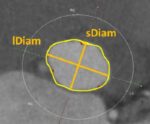Original title: Transcatheter Aortic Valve Replacement for Severe Symptomatic Aortic Stenosis Using a Repositionable Valve System. 30-Day Primary Endpoint Results From the REPRISE II Study. Reference: Ian T. Meredith AM et al. J Am Coll Cardiol 2014;64:1339–48. Transcatheter aortic valve replacement (TAVR) showed results comparable to those of surgery in patients at high surgical risk, but complications can<a href="https://solaci.org/en/2015/01/29/results-of-the-new-repositionable-and-retrievable-percutaneous-valve-system/" title="Read more" >...</a>
Promising results of TAVR in Bicuspid Aortic
Original title: Transcatheter Aortic Valve Replacement in Bicuspid Aortic Valve Disease. Reference: Darren Mylotte, et al. J Am Coll Cardiol 2014;64:2330-9 The bicuspid aortic valve (BAV) is present between 0.5% and 2% of the general population and up to 20% of patients older than 80 years who require aortic valve surgery. Literature on transcatheter aortic valve<a href="https://solaci.org/en/2015/01/08/promising-results-of-tavr-in-bicuspid-aortic/" title="Read more" >...</a>
Third generation percutaneous aortic valve in intermediate-risk patients
Original title: Multicenter Evaluation of a Next-Generation Balloon-Expandable Transcatheter Aortic Valve. Reference: John Webb, et al. J Am Coll Cardiol 2014;64:2235-43 Percutaneous aortic valve replacement is starting to be a reasonable alternative in patients at intermediate risk. One hundred and fifty patients who received SAPIEN 3rd generation percutaneous aortic valve implantation were analyzed prospectively. The STS score of<a href="https://solaci.org/en/2015/01/02/third-generation-percutaneous-aortic-valve-in-intermediate-risk-patients/" title="Read more" >...</a>
TAVI, also a promising option for severe aortic regurgitation
Original title: Initial German Experience With Tranapical Implantation of a Second-Generation Trascatheter heart Valve for the Treatment of Aortic Regurgitation. Reference: Moritz Seiffert, et al. JACC Cardiovasc Interv. 2014 Oct;7(10):1168-74. There is a group of patients with severe aortic regurgitation and they are not candidates for surgery; percutaneous implant is an option, but until now, there is little<a href="https://solaci.org/en/2014/11/11/tavi-also-a-promising-option-for-severe-aortic-regurgitation/" title="Read more" >...</a>
Core Valve in high-risk patients, superior to surgical replacement at one year
Original title: Transcatheter Aortic-Valve Replacement with a Self-Expanding Prosthesis. Reference: David H. Adams et al. N Engl J Med. 2014 Mar 29. [Epub ahead of print]. Transcatheter Aortic valve replacement (TAVR) with balloon expandable valve showed survival improvement in inoperable patients and was similar to surgery inoperable high-risk patients. An alternative to the above device is the self-expandable<a href="https://solaci.org/en/2014/04/09/core-valve-in-high-risk-patients-superior-to-surgical-replacement-at-one-year/" title="Read more" >...</a>
Results of aortic valvuloplasty in the era of TAVI
Original title: Balloon aortic valvuloplasty in the era of transcatheter aortic valve replacement: Acute and long-term outcomes. Reference: Hélène Eltchaninoff et al. Am Heart J 2014;167:235-40. Late 80s initial enthusiasm in aortic valvuloplasty was quickly tempered with the publication of several studies showing a high rate of complications, poor durability and little or no impact on survival. Since<a href="https://solaci.org/en/2014/02/05/results-of-aortic-valvuloplasty-in-the-era-of-tavi/" title="Read more" >...</a>
Silent cerebral embolism during percutaneous valve implantation does not appear to cause cognitive impairment
Original title: Cognitive trajectory after transcatheter aortic valve implantation. Reference: Ghanem A et al. Circulation Cardiovasc Intervent. 2013;Epub ahead of print Several studies showed that silent cerebral embolism in patients undergoing percutaneous aortic valve replacement is frequent but seems that does not affect the long-term cognitive functions according to this new study. This study included 111 patients<a href="https://solaci.org/en/2013/10/29/silent-cerebral-embolism-during-percutaneous-valve-implantation-does-not-appear-to-cause-cognitive-impairment/" title="Read more" >...</a>
Flow-Gradient Patterns can help in the selection of patients with aortic stenosis
Original title: Flow-Gradient Patterns in Severe Aortic Stenosis UIT Preserved Ejection Fraction. Clinical Characteristic and Predictos of Survival. Reference: Eleid, M, et al. Circulation 2013;128:1781-1789 Severe aortic stenosis is usually defined by echocardiography as a 40 mm mean transvalvular gradient Hg at >4 m/s; but there are low flow or paradoxical low flow cases with different evolution. 1704<a href="https://solaci.org/en/2013/10/22/flow-gradient-patterns-can-help-in-the-selection-of-patients-with-aortic-stenosis/" title="Read more" >...</a>
Automatic measurement of the aortic annulus by TAC , more precisely to choose the correct valve size.
Original title: Automated 3-Dimensional Aortic Annular Assessment by Multidetector Computed Tomography in Transcatheter Aortic Valve Implantation. Reference: Yusuke Watanabe et al. J Am Coll Cardiol Intv 2013;6:955–64. Percutaneous aortic valve implantation ( TAVI ) has emerged as an alternative for patients with severe aortic stenosis and high surgical risk. While this technique was improved over the time, residual paravalvular regurgitation<a href="https://solaci.org/en/2013/09/26/automatic-measurement-of-the-aortic-annulus-by-tac-more-precisely-to-choose-the-correct-valve-size/" title="Read more" >...</a>
Aortic Valvuloplasty in the transcatheter aortic valve implantation era
Original title: Emerging indications, in-hospital and long-term outcome of balloon aortic valvuloplasty in the transcatheter aortic valve implantation era. Reference: Francesco Saia et al. EuroIntervention 2013;8:1388-1397 Until a few years ago, aortic valvuloplasty had been abandoned by many centers due to its limited results and frequent complications. The current guidelines recommend aortic valvuloplasty to treat patients with symptomatic<a href="https://solaci.org/en/2013/05/21/aortic-valvuloplasty-in-the-transcatheter-aortic-valve-implantation-era/" title="Read more" >...</a>









